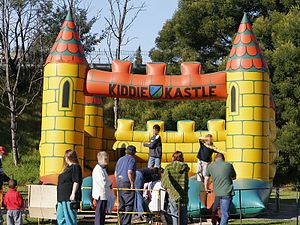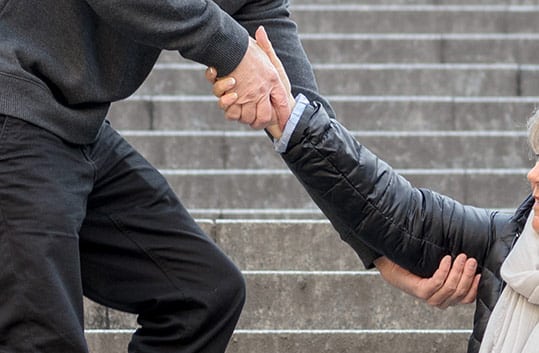You show up at a birthday party, a fair or a carnival, and your kids see it from a mile away – those giant inflatable rides and “bounce houses. It’s the first thing the kids want to go on, and they won’t stop asking until they get the answer they are looking for.
Most parents won’t think twice about letting their kids go and play on one of these rides, but should they? A recent rash of serious accidents all over the country involving improperly installed and maintained inflatables should cause parents to pause before they let their children get on board.
Earlier this month, three inflatables flew off the ground during a youth soccer tournament in Oceanside, N.Y. A mother was critically injured and numerous children suffered minor injuries. In all, 13 people were hospitalized.
At least 10 other inflatables around the country have been blown over by winds or collapsed under too much weight in the last two months. More than 40 people were injured in those incidents, according to www.rideaccidents.com.
In late April, The Associated Press said two slides collapsed at events in California, injuring nine children.
With all of these accident reports piling up, are inflatables still safe?
Luckily, we knew just who to ask for the answer to these questions. Bob Kramarik, longtime friend of the Ziff Law Firm and proprietor of Bobby K Entertainment, operates inflatables all over the Northeast, so we asked him to tell us how parents can decide whether it’s safe to let their children join the fun.
QUESTION: Bob, why have there been so many accidents recently?
BOB: First, I’m not sure there are a lot more accidents as a percentage. The number of operators and inflatables being offered and used has skyrocketed in recent years. Unfortunately, there is a lack of oversight and many operators have no training or understanding of what they are dealing with.
QUESTION: How do you ensure safety with your inflatables?
BOB: There are several factors. Inflatables come in different quality levels so we opt for the better-made models. Better-made equals safer in most cases. We also follow the manufacturer specifications for setup and use of the individual items as they vary from inflatable to inflatable. Finally, nothing is a substitute for proper training of your staff.
QUESTION: You are a member of the State Advisory Board for Amusements and the national Responsible Operators of Amusement Rentals. What does each organization do?
BOB: The State Advisory Board works with the New York State Labor Department to give them real experience input as they look at how to improve safety for participants while being realistic about what they require of the businesses who provide the activities. In some other states, regulations have been so strict as to force businesses to stop offering certain attractions.
ROAR (Responsible Operators of Amusement Rentals) was formed by a group of business owners who wanted to set standards of safety and responsible behavior among the amusement operators. Their greatest achievement has been to create a training course for inflatable safety and operation that is used by the state of Pennsylvania and is a template for many in-house trainings.
QUESTION: What can parents do when they arrive somewhere where there are inflatables? Is there a quick way to check for their safety?
BOB: There are several items to watch for to ensure safety, but the three most important in my opinion would be: 1. Is it properly weighted down by stakes, sand bags or water bags at each tether point; 2) Is there a supervisor who is paying attention and looks engaged; and 3) Are there any dangerous items in the vicinity that could affect play? Dangerous items could include vehicles, power lines, sharp objects or other items that should be clear of an inflated ride.
QUESTION: Should parents just avoid inflatables on windy days?
BOB: Several of the accidents recently have occurred because of wind gusts, not just regular wind. Each inflatable should have a wind rating that is based on proper inflation and staking. Responsible operators should have wind gauges or meters to determine if they are within the recommended rating. When in doubt, don’t go on an inflatable!
QUESTION: What’s your best advice to wary parents?
BOB: Unlike mechanical rides that always have someone very familiar with the ride operating it, inflatables are often provided to events by “friends”, rental companies where you pick up the piece and deliver it yourself, drop off companies that just drop it off and you are on your own, or small companies with poorly trained or no staff.
If you are at an event, check for proper supervision. Usually, these people would be in some type of uniform to distinguish them from the participants. Any inflatable that is over 20 feet tall requires extra supervision for safety.
Most importantly, parents need to pay attention. Inflatables are not babysitters, and ultimately, you are responsible for your child’s safety.
To learn more about Bobby K, check out Bob’s blog here.
Thanks for reading, and stay safe this summer!
_______________________________
ZiffLaw Attorney, Esq.
NY and PA Injury and Accident Attorney
The Ziff Law Firm, LLP
303 William Street
Elmira, NY 14901
Phone: (607)733-8866
Fax: (607)732-6062
Email: info@zifflaw.com
www.zifflaw.com



